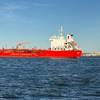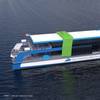Armed Canadian sailors seized control of the U.S.-owned ship GTS Katie last week after a high-seas standoff in which hundreds of millions of dollars of Canadian military equipment had effectively been held hostage.
The Ukrainian captain of the Katie engaged the ship in violent maneuvers as a Sea King helicopter sought to drop the sailors by cable on deck to take over the vessel in the North Atlantic, the commander of the naval operation reported.
But within 50 minutes the Canadians had grabbed full control, with no injuries to sailors or the crew of the ship, which had been embroiled in a bitter commercial dispute between its owner and the Canadian firm that chartered the vessel.
"Canada is obliged to ensure the arrival of its military equipment, and we had to take action," Defense Minister Art Eggleton told a news conference in Ottawa as he described what the military dubbed "Operation Megaphone."
"No responsible government can allow interference with its important military capabilities."
The Katie, owned by Maryland-based Third Ocean Marine Navigation, had been bringing $150 million of tanks and other military equipment -- about a tenth of the army's hardware -- home from peacekeeping in Kosovo.
Third Ocean, contending that Montreal charterers Andromeda Navigation had said it would withhold payments, had halted the vessel in the Atlantic Ocean off Newfoundland to force home its point.
The squabble drew in the Canadian government, which grew increasingly impatient to retrieve its cargo along with three Canadian soldiers monitoring the shipment.
The haggling was, in the end, apparently over a mere $100,000. But Eggleton said more was at stake. "It was a lot more than that. It was a question of trust, a question of principle here as well. Being held hostage, having our equipment held hostage is not something that is acceptable to us," he said.
The destroyer HMCS Athabaskan and the frigate HMCS Montreal had been shadowing the Ukrainian-built vessel for the past several days, and finally Eggleton gave the order to board.
A Sea King helicopter sent out one landing party and -- because a second of the aging aircraft was not working -- then returned to lower another. Fourteen sailors in total landed, joined by the three soldiers who had been on board all along.
Athabaskan commander, Capt. Drew Robertson, described the operation by radio phone.
"Just prior to its (the helicopter's) arrival, a warning was given Katie to hold her course and speed and to make sure that no personnel went in the vicinity of the helicopters...
"The Katie reacted instantly to the safety hail by maneuvering violently and initiating a distress call on marine radio, that is, a May Day call."
He said the ship speeded up from 11 knots to as much as 19 knots and zig-zagged, complicating the helicopter pilot's efforts to hold steady over the deck.
The ship's captain, Vitaly Khlebnikov, told his side to CTV News: "I advised them that approaching in helicopters was very dangerous because the ship has on board a 500-tonne explosive cargo, and any casualty make a big explosion."
After the boarding, Khlebnikov and his crew were ordered to steer the ship to the mouth of the St. Lawrence River. It is now due to arrive at the St. Lawrence port of Becancour, Quebec, on Sunday, before proceeding to Montreal.
The Katie was supposed to have arrived on July 14, and Eggleton said further delay would have jeopardized commercial contracts to refurbish the military gear. It would have also endangered Canada's ability to reinforce other peacekeeping operations, he said.
The boarding, south of Newfoundland, began at 1:45 p.m. (1745 GMT). Almost 13 hours earlier, the Katie had begun steaming toward the St. Lawrence, but Eggleton said boarding had still been required because the owners had said they intended to halt the ship again before reaching Canadian waters.
April 2025
 Read the Magazine
Read the Magazine

 Read the Magazine
Read the Magazine
This issue sponsored by:

Modernizing Mariner Credentialing: A Maritime Workforce Imperative
Subscribe for
Maritime Reporter E-News
Maritime Reporter E-News is the maritime industry's largest circulation and most authoritative ENews Service, delivered to your Email five times per week












